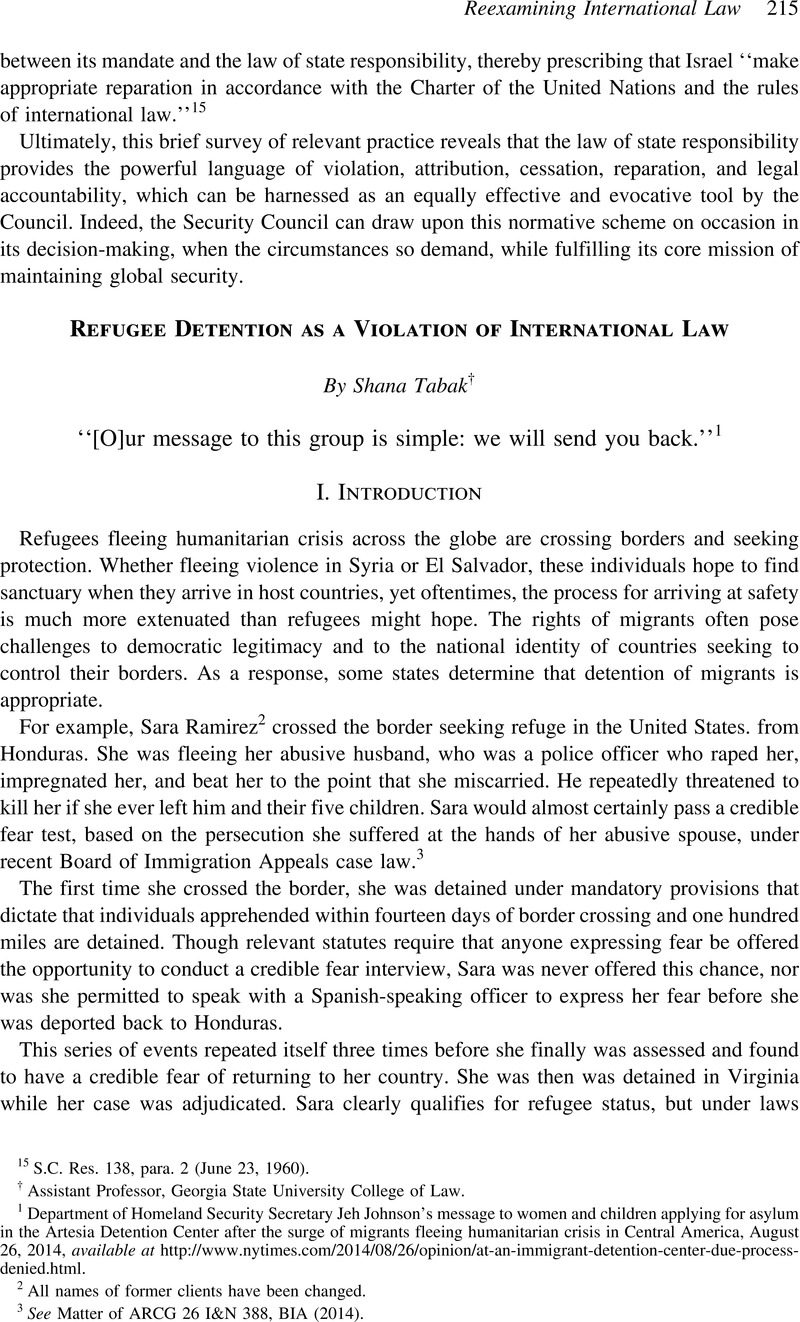No CrossRef data available.
Published online by Cambridge University Press: 18 May 2017

1 Department of Homeland Security Secretary Jeh Johnson's message to women and children applying for asylum in the Artesia Detention Center after the surge of migrants fleeing humanitarian crisis in Central America, August 26, 2014, available at http://www.nytimes.com/2014/08/26/opinion/at-an-immigrant-detention-center-due-process-denied.html.
2 All names of former clients have been changed.
3 See Matter of ARCG 26 I&N 388, BIA (2014).
4 United Nations Convention Relating to the Status of Refugees, July 28, 1951, 189 UNTS 137, 152–53 [hereinafter Refugee Convention]. The Article 33 prohibition reads, “No Contracting State shall expel or return (‘refouler’) a refugee in any manner whatsoever to the frontiers of territories where his life or freedom would be threatened on account of his race, religion, nationality, membership of a particular social group or political opinion.” The Convention Against Torture (CAT) also prevents refoulement. Convention Against Torture and Other Cruel, Inhuman or Degrading Treatment or Punishment, Art. 3(1), Dec. 10, 1984, 1465 UNTS 85 (“Where there are substantial grounds for believing that [they] would be in danger of being subjected to torture.”).
5 Id.; UN High Comm’r for Refugees, Detention Guidelines: Guidelines on the Applicable Criteria and Standards Relating to the Detention of Asylum-Seekers and Alternatives to Detention (2012), archived at http://perma.cc/0ZwerDWfGx.
6 Gilman, Denise, Realizing Liberty, Human Rights and Detention, 36 Fordham Int'l L.J. 243, 272 (2013)Google Scholar. Gilman also notes that in addition to these three requirements, the Inter-American Commission on Human Rights and other bodies have occasionally demanded free legal representation be provided to detainees (See Velez Loor, Inter-Am. Ct. H.R. (ser. C) No. 218, paras. 132, 146).
7 See International Covenant on Civil and Political Rights, Dec. 16, 1966, 999 UNTS 171 [hereinafter ICCPR] (Arts. 9(1) (“No one shall be deprived of his liberty except on such grounds and in accordance with such procedures as are established by law.”); 14(1) (“[E]veryone shall be entitled to a fair and public hearing by a competent, independent and impartial tribunal … .”)).
8 See Denmore v. Kim, 538 U.S. 510, 523 (2003), see also Lozada v. INS, 857 F 2d 10.13 (1st Cir.. 1988) (stating that individuals in deportation proceedings are entitled to due process).
9 Noferi, Mark, Cascading Constitutional Deprivation: The Right to Appointed Counsel for Mandatorily Detained Immigrants Pending Removal Proceedings, 18 Mich. J. Race & L. 63 (2012)Google Scholar (arguing that a right to counsel is constitutionally viable and practically feasible).
10 See Symposium, Innovative Approaches to Immigrant Representation: Exploring New Partnerships, 33 Cardozo L. Rev. 357, 363–64 (2011) (explaining that detained migrants in removal proceedings in New York City went unrepresented at a rate of 60 percent, which is much higher than the rate for nondetained individuals, and additionally, unrepresented detained individuals have only a 3 percent success rate in achieving permission to remain in the United States); see also Schoenholtz, Andrew I. & Bernstein, Hamutal, Improving Immigration Adjudications Through Competent Counsel, 21 Geo. J. Legal Ethics 55, 55–56 (2008)Google Scholar (pointing out that detainees are more limited than nondetained migrants in obtaining counsel and representation is the “single most important nonmerit factor” determining outcomes in immigration proceedings).
11 U.S. Immigrations and Customs Enforcement, Detention Facility Locator, at https://www.ice.gov/detention-facilities
12 Hernández, César Cuauhtémoc García, Due Process and Immigrant Detainee Prison Transfers: Moving LPRs to Isolated Prisons Violates Their Right to Counsel, 21 Berkeley La Raza L.J. 17, 21, (2011)Google Scholar.
13 This finding is supported by a variety of cases and reports from NGOs. See, e.g., Denmore v. Kim, 538 U.S. 510, 554 (2003) (Souter, J. concurring in part, dissenting in part) (lamenting the INS's power to detain, transfer, and isolate aliens away from their lawyers, witnesses, and evidence).
14 CAIR Coalition, Guide to Representing a Detained Immigrant, at http://www.caircoalition.org/wp-content/files_mf/1391555303CAIRCoalitionPracticeManualforRepresentingUnaccompaniedImmigrantChildrenJan312014.pdf.
15 Noferi, supra note 9, at 66 (Citing a New York Immigrant Representation Study: Accessing Justice: The Availability and Adequacy of Counsel in Immigration Proceedings, 33 Cardozo L. Rev. 357, 363–64 (2011). The study found that a stunning 97 percent of detained and nonrepresented immigrants were unsuccessful in their removal proceedings, while 74 percent of nondetained and represented immigrants successfully stayed in America.).
16 See, e.g., Julia Preston, U.S. Faces Suit Over Tactics at Immigration Detention Center, N.Y. Times (Aug. 22, 2014), at http://www.nytimes.com/2014/08/23/us/us-faces-suit-over-tactics-at-immigrant-detention-center.html.